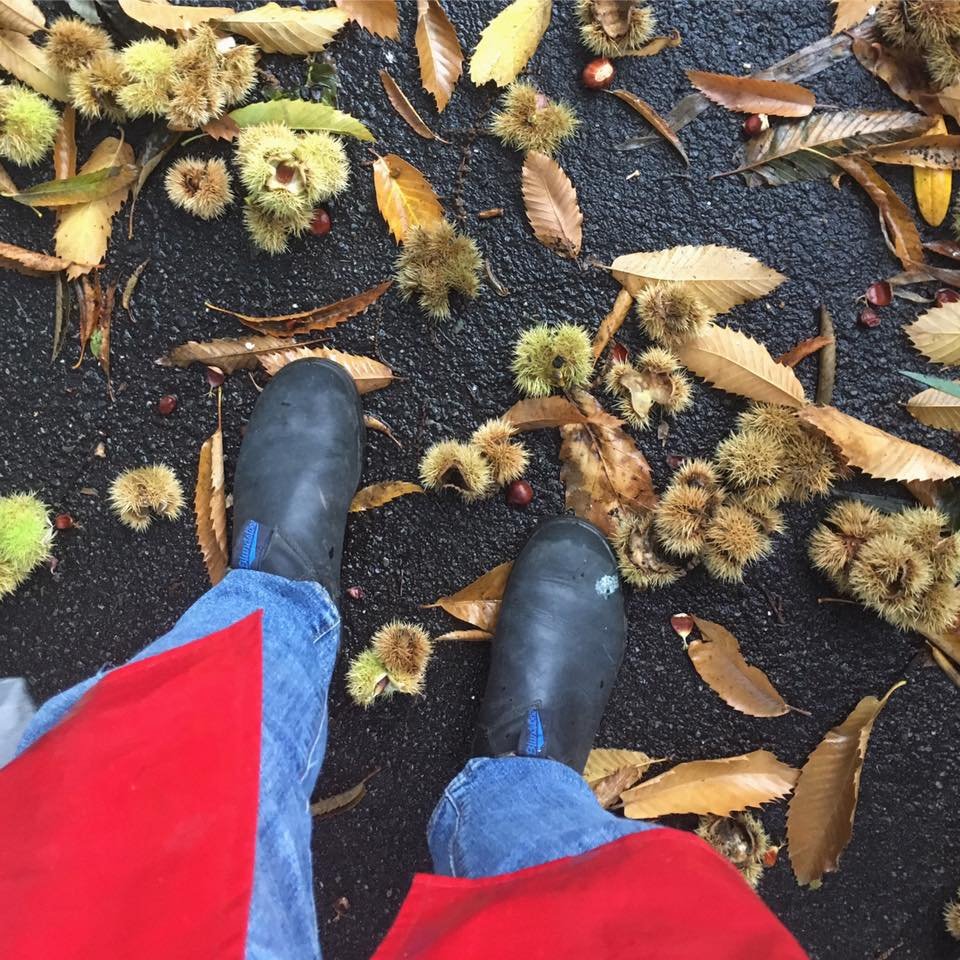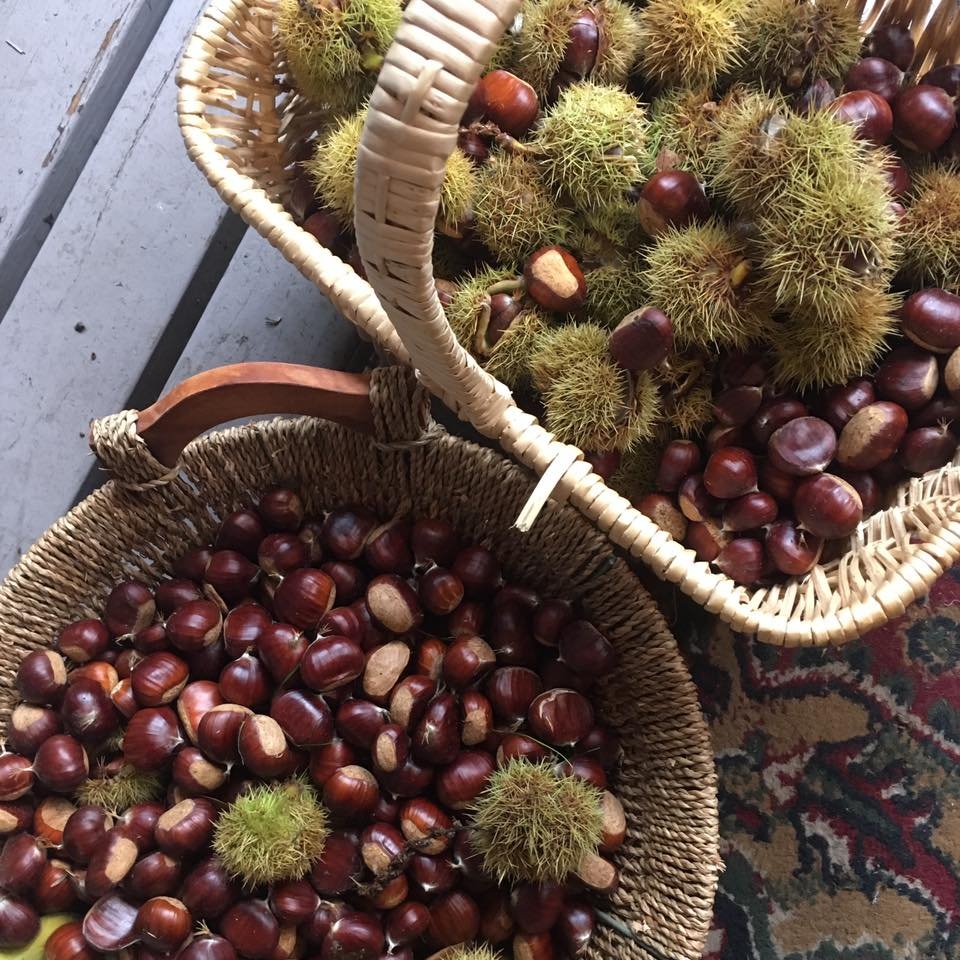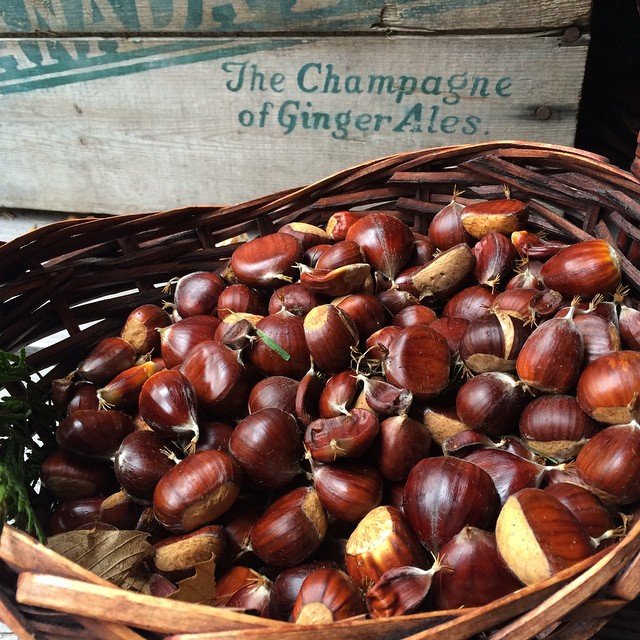Chestnuts, Neruda & A Recipe For Crème de Marrons
I adore chestnut season. And by season, I mean post-windstorm sometime in mid-October. There’s just something so cheering and magical about fallen chestnuts. I know of only a few trees here in the city—tall, stately ones lining a couple of boulevards in older neighbourhoods.
Ode to a Chestnut on the Ground ~ Pablo Neruda
From bristly foliage you fell
complete, polished wood, gleaming mahogany,
as perfect as a violin newly
born of the treetops,
that falling
offers its sealed-in gifts
the hidden sweetness
that grew in secret
amid birds and leaves,
a model of form,
kin to wood and flour,
an oval instrument
that holds within it
intact delight, an edible rose
A few weeks ago, we were expecting heavy storms to sweep through the Pacific Northwest. Thankfully, it mostly bypassed the island, but not before high winds swept through the chestnut trees to rattle a bounty of nuts to the ground. We donned our slickers and braved the gusting rain to collect several baskets full. My six-year-old loves kicking through the spiky casings, looking for the small glossy treasures hidden inside. We made sure to wear thick wooly hats to protect our heads against falling chestnuts though that did little to protect my other bent over from from meeting the business end of a small bristling branch. It shocked me more than it hurt and it sent my son into seemingly never ending giggles. Seriously, he laughed for a long time. Butt injuries are hilarious to first graders. Schadenfreude is strong in that boy.
In the heights you abandoned
the sea-urchin burr
that parted its spines
in the light of the chestnut tree;
through that slit
you glimpsed the world,
birds bursting with syllables,
starry dew below,
the heads of boys and girls,
grasses stirring restlessly,
smoke rising, rising.
Note: Make sure you’re not collecting Horse Chestnuts! These relatives of the sweet chestnut look somewhat similar to the untrained eye, but sadly aren’t good eating. Great topical medicine for oedema or even cellulite, but toxic when eaten. You probably won’t die, but you will experience severe GI distress. A little research and you’ll be able to tell the two apart easily.
You made your decision,
chestnut, and leaped to earth,
burnished and ready,
firm and smooth
as the small breasts
of the islands of America.
Right, now where was I? Oh, yes—waxing poetic about foraging for chestnuts. Now, the only real drawback to gathering chestnuts is that you actually have to do something with all those gorgeous impenetrable little fortresses of deliciousness. They do not give up their innards without a fight. We’ll get to that.
You fell,
you struck the ground,
but nothing happened,
the grass still stirred,
the old chestnut sighed with the mouths
of a forest of trees,
a red leaf of autumn fell,
resolutely, the hours marched on
across the earth.
First thing’s first. You’ll have to go through the chestnuts and discard any wrinkly or weevily ones. I’m just going to go ahead and jinx myself here and announce that I’ve yet to come across a wormy chestnut. Wipe the chestnuts with a damp towel and lay them out on a table in a single layer. If you have such a thing as a drying rack, that would be wonderful. I laid my out on a table in a dry airy room and let them sit like that for four days. This will sweeten them up a bit.
Because you are only a seed,
chestnut tree, autumn, earth,
water, heights,
silence prepared the germ,
the floury density,
the maternal eyelids
that buried will again
open toward the heights
the simple majesty of foliage,
the dark damp plan of new roots,
the ancient but new dimensions
of another chestnut tree in the earth.
Every year I approach the task of shelling chestnuts with a heartbreaking mix of unrealistic optimism and grim determination. I research the same sites over and over looking for tips to make the next few days of my life less miserable. And here’s what works best for me. And by best, I do mean the least shitty. Some nuts will burn your hands. Some will crumble when you try to peel them. Sometimes the tough hairy inner skin has a deathgrip on the lovely yellow nut underneath. Me? I simply lower my standards. I guarantee you I’ve eaten a lot of that inner skin. Who am I to get between that kind of devotion? If you’re eating them straight up, nothing beats roasted chestnuts. Just score them and roast them in a cast-iron pan for 30 minutes in a 400 C. But for the sake of this recipe, steaming works well. Chop them in half and steam them for 20 minutes
And what exactly is crème de marrons? Well, obviously it translates to “cream of chestnuts”, but it’s not really a cream. It’s a terrifically sweet nut conserve and it’s very French. It was invented by French confectioner Clément Faugier in 1885 and since then Crème de Marrons de l'Ardèche has been a staple of French children and chefs alike. My half-French husband speaks wistfully of visiting Lyon as a child and eating it directly out of an aluminum tube.
You can usually find it, usually tinned, in specialty food stores or at better grocers. But, that would be easy. That’s not for folks like you and me. We MAKE things. Sometimes until 3 AM. And then we curse the things we make. However, you’ve come this far, so let us make us some fancy French chestnut conserve. En français, s’il vous plaît! This recipe is pretty much Frankensteined together from different recipes and trial and error. Once you get past the shelling and shucking, it’s dead easy.
Recipe: Crème de Marrons (Chestnut Conserve)
Ingredients:
fresh chestnuts
organic cane sugar
vanilla bean
water
sea salt
Step 1: Peel. Cut the chestnuts in half using a serrated edge knife. Bring a pot with 2 inches of water to a boil and fill a steamer basket with the chestnuts. Working in small batches (a cup at a time) lower the chestnuts into the pot so that they stay above the boiling water, cover and steam 20 minutes. Remove the chestnuts from the steamer and start peeling as soon as you can bear it. Keep them wrapped in a kitchen towel to keep them warm. Once they cool they’re monstrous to peel. Pull off the thick brown shell and if the chestnut goddesses are smiling on you, the inner skin will come off, too. If not, try rubbing it off with the towel. If that fails use a small paring knife and get scraping! It’s exactly as fun as it sounds. Also, keep some aside for snacking. Chestnuts are high in fibre, antioxidants and Vitamins B and A. They also help build stronger bones and contain complex carbohydrates to help maintain energy levels. You will need this after all that peeling.
Step 2: Cook. Put the peeled nuts and the inevitable frustrating little piles of chestnut crumble into a deep pot. Add a good pinch fo sea salt and enough water (you can use your chestnut water) just to cover and bring to a simmer. Cook for about 30 minutes or until the nuts are tender. You may end up with extra liquid or you may not. This is one of those mysteries I have decided to move on from. Last year I had to drain them. This year I did not. Go figure.
Step 3: Purée. I used my trusty OXO food mill to purée the softened chestnuts. You can also use a food processor. Whatever mushes your chestnuts.
Step 4: Weigh. I used a kitchen scale to weigh the chestnut purée. You’ll want to add an equal amount of cane sugar. I wound up with 1300 grams. Put the sugar &purée back in the pot and stir. Add 100 ml of water for every 1 kg of sweetened purée. Add a split vanilla bean to the pot.
Step 5: Cook. Again. Bring the now already wonderfully fragrant mixture to a simmer. Using a wooden spoon, stir constantly to keep your hard won spoils from burning. It’s ready when it starts to pull away from the sides of the pot or when you like the look of it.
Step 6: Preserve your conserve. Remove the vanilla bean and pour the piping hot mixture into hot sterilized canning jars (washed and rinsed in boiling water). Now here is where it gets confusing. Because chestnuts aren’t acidic, the thought is that you cannot safely preserve this conserve in a hot water bath—it would have to be pressure canned. Though I think that might be overkill and could potentially compromise the jam. However, most European recipes recommend a hot water bath and storage in a cool space. There does seem to be consensus that the conserve will keep for a couple of months, unprocessed in the fridge. Not one to pick sides, I did a 15-minute hot water bath and then stored the preserved jars in the fridge. I don’t expect them to hang around too long as we’re going through it pretty quickly and I’ll be gifting the rest for Christmas. It’s kind of the perfect host gift.
Crème de marrons is best (in my opinion) served on a thick buttered slice of rustic bread. It’s also lovely between cake layers or dolloped in yogurt. Bon appetit!
Medicinal properties: Sweet Chestnut (Castanea vesca) leaves are astringent & high in Vitamin K. Tea made from the leaves is used to treat respiratory diseases such as whooping cough, and mixed with thyme makes a powerful medicinal syrup that is used to treat cough, diarrhea, backache and intoxication.
Magical properties: fertility, desire, abundance.



